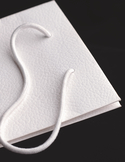The skin brands live in
29 September 2011James Cropper Speciality Papers supplies bespoke uncoated and deep-coloured papers for luxury brand packaging. Joanne Hunter visited the sixth-generation family firm in the English Lake District
Luxury paper packaging is the face of a brand; and the substrate is the skin the brand lives in, and by which it is recognised and can be authenticated. A brand will live in the same skin for years. For the sake of consistency, packaging change is resisted. But sometimes an irresistible opportunity opens up to shed that old, familiar skin for a new one that fits just as perfectly and which lends even greater distinction.
Such a packaging transformation happened when James Cropper Speciality Papers had a breakthrough with a technical innovation that gives a sensuous suede leather-effect texture. This bespoke solution bowled over the brand, which rolled it out in new-look, new-feel packaging. Versions of that substrate are being developed to tempt others to break with tradition.
“We have the speed, output and yield and are still working on new properties,” says Jacqueline Redman, marketing manager for James Cropper Speciality Papers. The teams on both sides “work as one” for rapid prototyping, and sampling can be done in 2.5 weeks, she adds.
Fast flow
The fast flowing waters of the English Lake District gave birth to what is, today, a thriving papermaking business. It has continued non stop since 1845, run by the Cropper family for six generations at Burneside, near Kendal.
You will never step twice into the same river, so they say, and the rush of variously coloured and textured speciality papers through the machinery brings a visitor to the same conclusion about this, arguably, unique operation.
A whirling “cottonwool mush” in a mixing tank transforms into flowing waves of tightly specified substrate, which then is conditioned ready for printing, coating, laminating and varnish.
A tailor-made recipe for the paper formula is precision engineered in the laboratory here, to an agreed specification adding to a library of 3,700 shades. A perfect match can be found for anything from a leaf to a piece of fabric, according to the company.
As Mark Starrs, responsible for colour formulations, explains: “It is important that we get as much information as we can [from the client] and important to know the end use, to pick dyes accordingly.” Around 45 different dyes and pigments are variously sourced to be sure of a secure supply that is crucial to a time-sensitive production process.
The sample to be matched is measured and a dye recipe is selected to give the least metameric match for the customer. The recommended dye combination is the one that varies least under three different lighting states, gauged by a light box: D65 is the standard Western (British) daylight at midday; another is typical retail fluorescent lighting; and a third is common household lighting conditions. Any colour change is clearly visible, confirming the importance of getting a customer to accept the lab match.
Kath Bowness puts the coloured samples through a battery of tests relevant to their applications. During Packaging Today’s visit, she was testing the pearlescent effect of a coating dye for a luxury paper. One pass in-line coating, when the result perfectly fits the brief, is “cost-effective, quicker and energy efficient”, she explained. Packaging papers also go through strength and fold testing and are checked for light-fastness, and bleed and rub resistance.
The lab also works on archival papers for boxes that museums and art galleries use for valuable and unique artifacts and exhibits. They need a pH of 8-10 to buffer the acidic effects of the air. Anti-microbial medical packaging papers are also produced here.
Pushing capabilities
The tight machine schedule allows for up to 150 shades to run in a week. Changing shade every two hours is a feat of planning and technical prowess. Small quantity orders can be as low as two tonnes, ranging between 70g/m² and 3,000 micron.
“We are pushing the capabilities of the machines. We are using technology and people as best we can, to optimise efficiency and profitability,” explains papermaking manager Steve Oxley.
“We develop a recipe using a computer reference, but the final call on the colour is done by eye. Dye can bond to paper fibres with different levels of strength. So the dye yield can differ because one dye will have a better affinity with one pulp type than another. We follow computer recommendations, then use the blenderman’s skill to make final adjustments.”
Roy Teasdale, an employee for 29 years, followed his grandfather, mother and father into the job of coating, embossing, laminating and varnishing. With obvious pride he says: “We can emboss 90g/m² to 700g/m², and always try to achieve what customers are asking for.” Established embossed designs such as Weave, Twill and Buckram are being added to all the time, new ones such as Grasscloth and exclusive ‘first-borns’ and their ‘siblings’ continue to evolve.
Following final processing, the paper is packed either as reels or sheets using automatic production lines or - for certain orders - skilled hand packers. The final destination of the product is the client’s packaging manufacturer or a specialist paper distributor which can be located anywhere in the world.
Cropper offers a wide choice of colours Colours Uniquely coloured and textured papers help build the character of a luxury brand Luxury A carrier bag made from Cropper paper exudes quality Carrier




